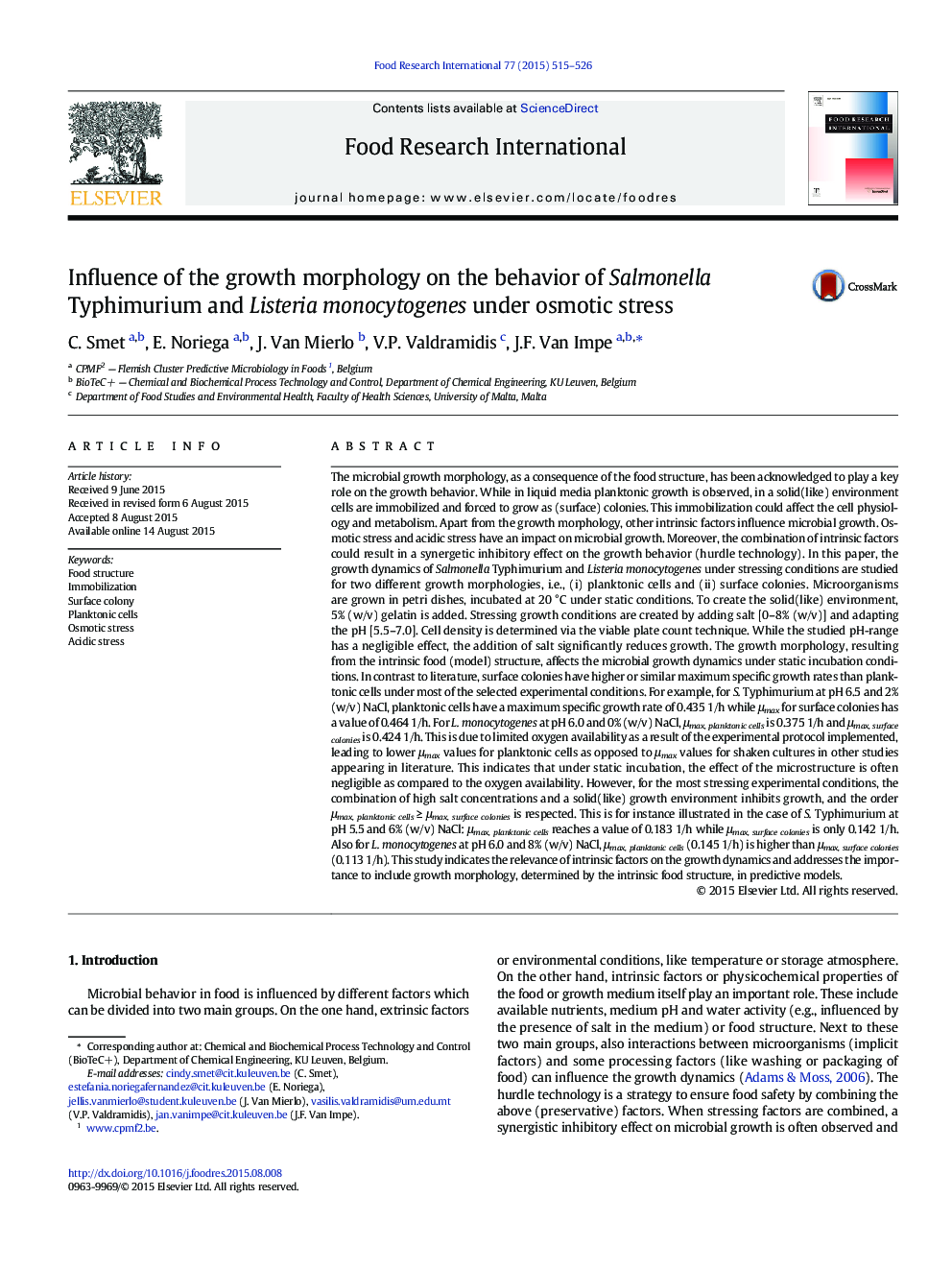| کد مقاله | کد نشریه | سال انتشار | مقاله انگلیسی | نسخه تمام متن |
|---|---|---|---|---|
| 4561372 | 1330641 | 2015 | 12 صفحه PDF | دانلود رایگان |

• Cell growth morphology, determined by food structure, influences microbial growth.
• Surface colonies often have a higher or similar μmax compared to planktonic cells.
• Oxygen availability and immobilization are key factors for microbial growth.
• The effect of osmotic stress is more pronounced for colonial growth.
The microbial growth morphology, as a consequence of the food structure, has been acknowledged to play a key role on the growth behavior. While in liquid media planktonic growth is observed, in a solid(like) environment cells are immobilized and forced to grow as (surface) colonies. This immobilization could affect the cell physiology and metabolism. Apart from the growth morphology, other intrinsic factors influence microbial growth. Osmotic stress and acidic stress have an impact on microbial growth. Moreover, the combination of intrinsic factors could result in a synergetic inhibitory effect on the growth behavior (hurdle technology). In this paper, the growth dynamics of Salmonella Typhimurium and Listeria monocytogenes under stressing conditions are studied for two different growth morphologies, i.e., (i) planktonic cells and (ii) surface colonies. Microorganisms are grown in petri dishes, incubated at 20 °C under static conditions. To create the solid(like) environment, 5% (w/v) gelatin is added. Stressing growth conditions are created by adding salt [0–8% (w/v)] and adapting the pH [5.5–7.0]. Cell density is determined via the viable plate count technique. While the studied pH-range has a negligible effect, the addition of salt significantly reduces growth. The growth morphology, resulting from the intrinsic food (model) structure, affects the microbial growth dynamics under static incubation conditions. In contrast to literature, surface colonies have higher or similar maximum specific growth rates than planktonic cells under most of the selected experimental conditions. For example, for S. Typhimurium at pH 6.5 and 2% (w/v) NaCl, planktonic cells have a maximum specific growth rate of 0.435 1/h while μmax for surface colonies has a value of 0.464 1/h. For L. monocytogenes at pH 6.0 and 0% (w/v) NaCl, μmax, planktonic cells is 0.375 1/h and μmax, surface colonies is 0.424 1/h. This is due to limited oxygen availability as a result of the experimental protocol implemented, leading to lower μmax values for planktonic cells as opposed to μmax values for shaken cultures in other studies appearing in literature. This indicates that under static incubation, the effect of the microstructure is often negligible as compared to the oxygen availability. However, for the most stressing experimental conditions, the combination of high salt concentrations and a solid(like) growth environment inhibits growth, and the order μmax, planktonic cells ≥ μmax, surface colonies is respected. This is for instance illustrated in the case of S. Typhimurium at pH 5.5 and 6% (w/v) NaCl: μmax, planktonic cells reaches a value of 0.183 1/h while μmax, surface colonies is only 0.142 1/h. Also for L. monocytogenes at pH 6.0 and 8% (w/v) NaCl, μmax, planktonic cells (0.145 1/h) is higher than μmax, surface colonies (0.113 1/h). This study indicates the relevance of intrinsic factors on the growth dynamics and addresses the importance to include growth morphology, determined by the intrinsic food structure, in predictive models.
Journal: Food Research International - Volume 77, Part 3, November 2015, Pages 515–526